Eurocom X5 (Clevo P177SM)
by Vivek Gowri on September 2, 2013 12:00 AM ESTWhen it comes to large gaming notebooks, battery life is never really a concern, but since NVIDIA’s Optimus graphics switching technology basically became standard on all Intel/NVIDIA notebooks across the board, it’s actually been possible to see a solid few hours of life out of this class of system. The sheer size of the notebooks typically allows for 90-100Wh batteries that would be considered absolutely massive by normal standards, so with the large display and high TDP quad, we’ve been seeing Haswell gaming notebooks end up in the 4 hour range for web-browsing battery life.
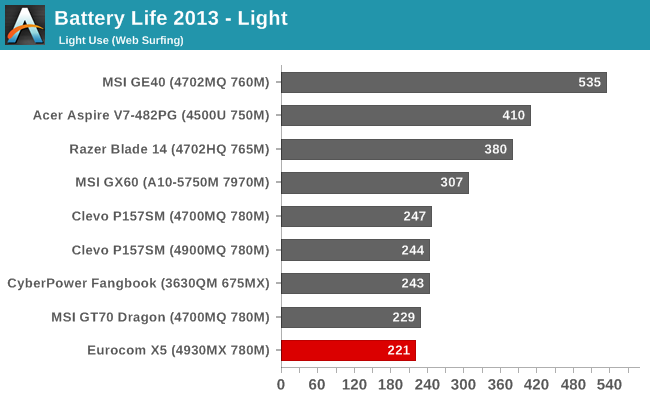
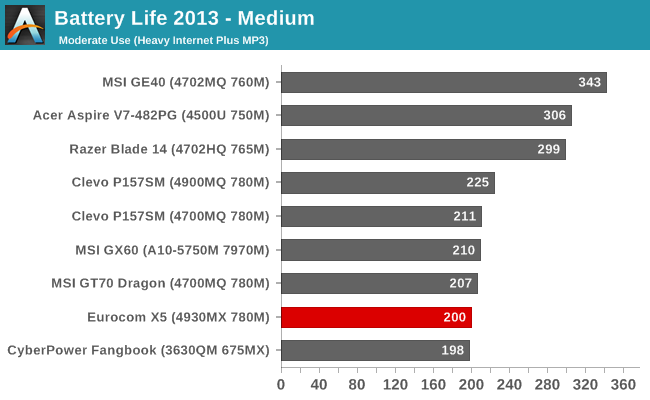
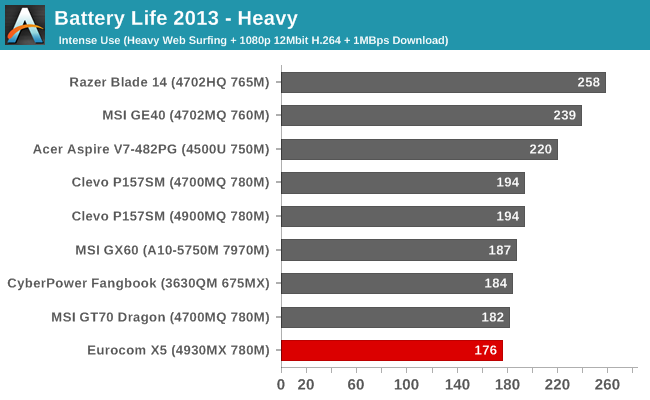
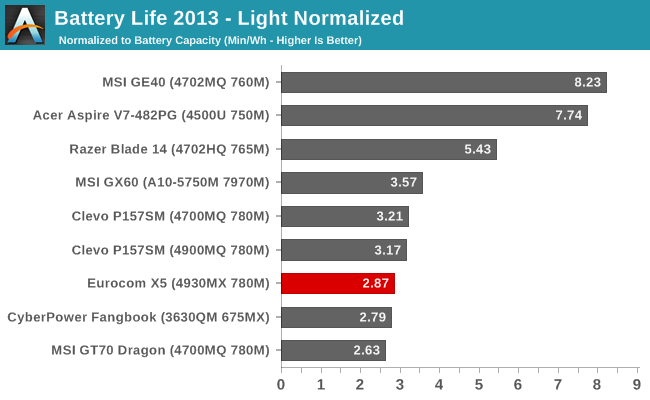
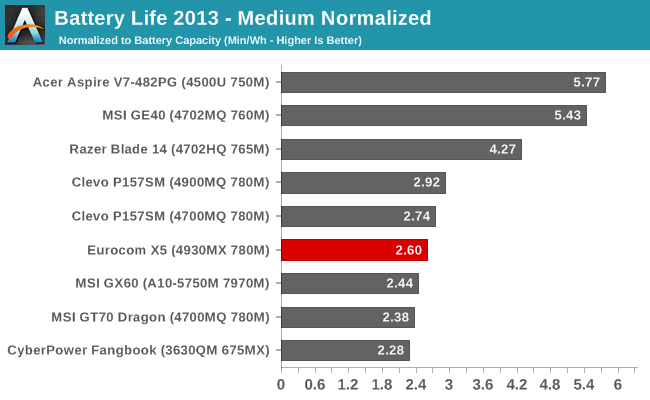
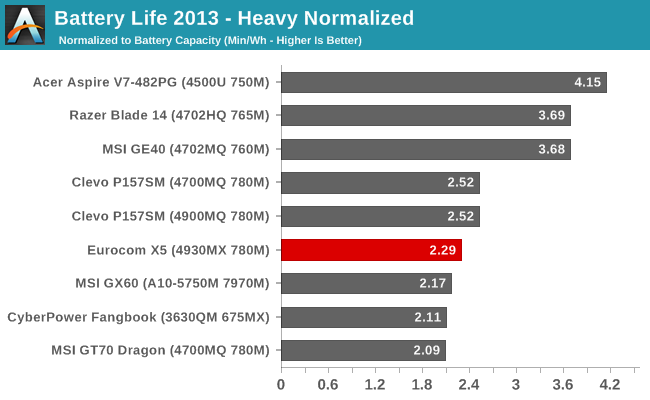
That’s honestly pretty impressive; I still remember the days when the batteries in 17” Alienwares and Clevos almost served more as uninterruptible power supplies than any kind of mobile power source. An hour or two would be considered good back then. Obviously, both CPU and GPU microarchitectures have gotten far more efficient in the last handful of years, and Optimus really changed things for the better.
None of our battery tests stress the CPU enough for the extra 10W TDP of the Extreme Edition to make a discernible difference in terms of battery life relative to the lower end mobile quads. Battery life is slightly lower than the Clevo P157SM we tested, but that had less RAM, a smaller LCD, and a single SSD (instead of an SSD and HDD), so a slight reduction in battery life is expected.
Our battery tests aren’t that intensive, mostly focusing on internet, music, and video use cases; there’s a lot of CPU idle time where we already know that Haswell excels, so this is no real surprise. Between the CPU and GPU, this system has a thermal envelope of roughly 160W under load, so the 77Wh battery would go pretty quickly under any sort of intensive workload (like gaming).










38 Comments
View All Comments
JarredWalton - Monday, September 2, 2013 - link
You have to make sure to compare similar configurations, though. Pro-Star and several others don't include the OS by default, for example, so that's at least $80. Mythlogic and Eurocom do LCD calibration for "free", which is worth at least $25 I'd say. Then look at default warranties and configuration options and go from there.I'd suggest an i7-3800MQ, GTX 780M, 2x8GB RAM, and a 240/256GB mSATA drive with 1TB HDD as a good baseline. Then toss in Windows 8 64-bit, 802.11ac, and upgrade the thermal compound just for kicks and you end up with the following prices:
AVADirect: $2402
Eurocom: $2457 (no 802.11ac)
LPC-Digital: $2379 (cash $2308)
Maingear: $2618 (no mSATA options other than caching - yuck!)
Mythlogic: $2331
Origin: $2629 (no 2x8GB RAM option, so this is 4x4GB)
Pro-star: $2324 (cash: $2254)
Sager: $2354
XoticPC: $2354 (cash: $2283)
I think that's most of the major resellers of Clevo notebooks in the US, and you can see that outside of Maingear and Origin, pricing falls around $2300-$2400. A couple places offer cash discounts, others offer additional customization options, etc. Looking at the configurators, I'm still partial to Mythlogic, simply because they offer 512GB mSATA drives and a few other nice extras. AVADirect is the only other place with 512GB mSATA, but I've never liked that their site requires you to click "update price", plus they don't pre-calibrate the LCD.
Anyway, it pays to shop around as always when purchasing something in this price range. Find the options you want, compare pricing, and if you have any additional knowledge of the support and customer service take that into account.
rpgfool1 - Monday, September 2, 2013 - link
I'm not a person willing to spend with bells and whistles, especially when it comes to the holidays like Black Friday and Christmas. That is reserved for my desktop PC. I know some resellers don't have the OS and installing drivers will be slow for a Clevo notebook. It's nice for some people who can afford those options, but in a few years they'll be obsolete due to new CPU and GPU (like Broadwell and Haswell refresh).DanNeely - Monday, September 2, 2013 - link
Is there any particular reason to go with an mSATA SSD? Cleavo's still putting dual 2.5" bays; so why not go with the generally a bit cheaper and better performing 2.5" models instead?JarredWalton - Monday, September 2, 2013 - link
mSATA is simply a nice way to get additional storage. Start with a large mSATA, and then adding 2.5" HDD, SSD, or SSHD is simply down the road. Finding reasonably priced retail mSATA is a bit trickier and with M.2 coming the future supply may be limited. Of course, technically mSATA drives are usually a bit slower than regular SATA, as they have fewer packages to work with so parallelism isn't quite as high. Not really a huge problem in my book, but if you need maximum SSD speeds then 2.5" drives are still a bit faster.MDX - Monday, September 2, 2013 - link
Couldn't buy anything Clevo, just too damn hideous. It's time for some style, guys (and not the apple version of style - aluminum/black got old years ago)...Calista - Monday, September 2, 2013 - link
Vivek, do you have any knowledge about why external graphics never made it to the world of laptops with the exception of low-powered solutions utilising Cardbus, ExpressCard or USB? With such a silly amount of different form-factors and often sky-high price-points I have a hard time understanding why no one have bothered with the concept. Especially since so many laptops are sold as "gaming laptops". Is it because of technical reasons? Since it seems quite easy creating a PCI-E 1x lane (as in ExpressCard) why not try scaling it it further?BlakKW - Monday, September 2, 2013 - link
This is a question I would really like to see explored. My guess is that moving the gpu outside the chassis doesn't decrease weight and increase battery life enough to make a gaming laptop "mobile" when undocked from gpu.While I like about the concept is the idea that I could use normal gpu's (780 vs 780m), and that it would come in a box like the power brick, which I could open and upgrade as needed.
Gadgety - Monday, September 2, 2013 - link
As in the Sonnet and Magma ExpressBox (up to three full length cards) via Thunderbolt? Magma's ExpressBox also comes in non-Thunderbolt variants for up to 7 cards.Calista - Tuesday, September 3, 2013 - link
Thunderbolt is barely three years old (and have seen very slow actual adoption), and the products you spoke about is also quite expensive, in the $400-$500 range excluding the card itself. Compare this to the common docking station which can be found in the $200 range, and this includes the "OEM markup", i.e. why a new OEM battery cost $150 while it can be found online from a third-party source for a third of the cost. A desktop GPU in the $200 range would do very well compared to also a high-end mobile GPU since power and cooling would be much less of an issue. Oh well, it's just speculation. Maybe mobility is worth more than price/absolute power for a gamer on the go.willis936 - Monday, September 2, 2013 - link
I'm done with notebooks after my now 5 year old ideapad desktop replacement. I still don't have reason enough to justify an upgrade though. POWERRR!!